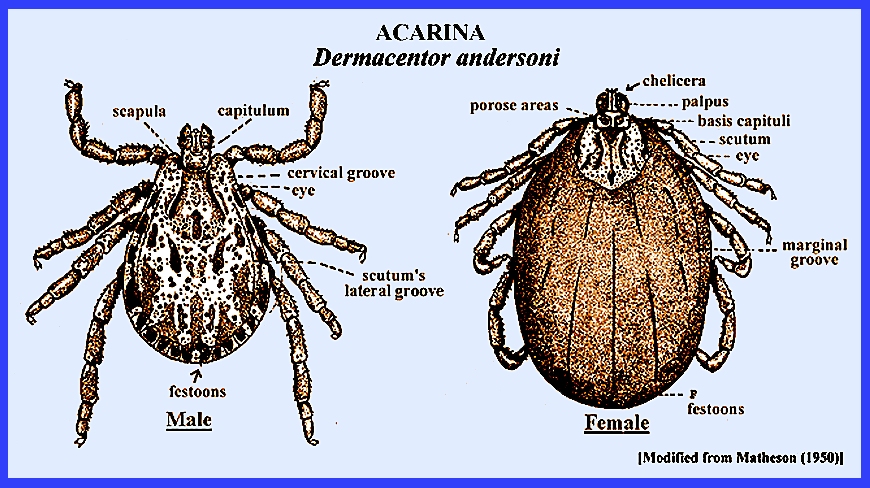File: <rockymountainfever.htm> <Medical
Index> <General Index> Site Description Glossary <Navigate
to Home>
|
ROCKY MOUNTAIN SPOTTED FEVER (Alternate Names = Mexican Spotted Fever & São Paulo Spotted Fever) (Contact) Please
CLICK on
Image & underlined links for details: Two strains of the disease, a mild and a virulent type,
exist through most regions where the disease is a problem. Mortality varies from around 80 percent
for the virulent strain and about 4-6 percent for the mild strain. The disease was named, Rocky Mountain Spotted Fever"
because of its apparent origin. The
causative agent is Rickettsia rickettsii. It is not contagious, but highly infectious
and transmitted to humans by ticks.
Service (2008) noted that is both transovarial and transstadial. Early
investigations revealed that the disease is mainly an infection of small
mammals, and large mammals, excluding humans, are not susceptible. Principal tick species involved include Dermacentor andersoni, and to
a restricted area Dermacentor sanguineus,
which are the vectors for humans in western North and Central America. Dermacentor variabilis
is the vector tick in eastern North America, while in South America Amblyomma
cajennense is the principal vector. Other vector species undoubtedly exist, such as Dermacentor
occidentalis and the rabbit tick, Haemaphysalis
leporis-palustris, which does not attack humans but can
maintain the Rickettsia in the
rodent population. Laboratory
transmission trials have succeeded with additional vector species as well. Studies have shown that the incubation period in humans
after the bite of infectious ticks varies from 2 to 12 days. Service (2008) reports that as an
infective tick has to feed on a host for at least two hours before sufficient
Rickettsiae are injected for
the host to become infected, early tick removal may prevent
transmission. Although Matheson
(1950) reported on a vaccine that gave some protection for almost one year,
there was no mention of it by Service (2008). LIFE CYCLE -
Rocky Mountain Spotted Fever = = = = = = = = = = = = = = = = = =
= = Key References: <medvet.ref.htm> <Hexapoda> Camicas, J. L., J. . Hervy, F. Adam & P. C.
Morel. 1998. The ticks of the world (Acarida,
Ixodida): Nomenclature, Described
Stages, Hosts, Distribution. Paris: Editions de l'ORSTOM. Dumler, J. S. & D. H. Walker. 2005.
Rocky mountain spotted fever: changing ecology and persisting
virulence. New England J. of Medicine 353:
551-53. Gammons, M. & G.
Salam. 2002. Tick removal. Amer. Fam. Physician 66:
643-45. Gothe, R., K. Kunze
& H. Hoogstraal. 1979. The mechanisms of pathogenicity in the
tick paralyses. J. Med. Ent. 16: 357-69. Hoogstraal, H. 1966.
Ticks in relation to human diseases caused by viruses. Ann. Rev. Ent. 11: 261-308. Hoogstraal, H. 1967.
Ticks in relation to human diseases caused by Rickettsia species. Ann. Rev. Ent. 12: 377-420. Jellison, W. L.
1945. The geographical distribution
of Rocky Mountain spotted fever and Nuttall's cottontail in the western
United States. U. S. Pub. Hlth. Repts. 60: 958-961. Matheson, R. 1950. Medical Entomology. Comstock Publ. Co, Inc. 610 p. Service, M. 2008.
Medical Entomology For Students.
Cambridge Univ. Press. 289 p. Needham, G. R. & P.
D. Teel. 1991. Off-host physiological ecology of ixodid
ticks. Ann. Rev. Ent. 36: 313-52. Parola, P. & D. Raoult. 2001.
Tick-borne typhuses. IN: The Encyclopedia of arthropod-transmitted
Infections of Man and Domesticated Animals. ed. M. W. Service,
Wallingford: CABI: pp. 516-24. Sonenshine, D. E., R. S. Lane & W.
L. Nicholson. 2002. Ticks
(Ixodida). IN: Medical & Veterinary Entomology, ed. G. Mullen & L.
Durden, Ambsterdam Acad. Press. pp 517-58. Sonenshine, D. E. &
T. N. Mather (eds.) 1994. Ecological Dynamics of Tick-Borne
Zoonoses. Oxford Univ. Press, New
York. Steer, A., J. Coburn & L. Glickstein. 2005.
Lyme borreliosis. IN: Tick-Borne Diseases of Humans, ed. J. L.
Goodman, D. T. Dennis & D. E. Sonenshine, Washington, DC: ASM
Press. Wolbach, S. B. 1919. Studies on Rocky Mountain spotted fever. J. Med. Res. 41: 1-197. |
